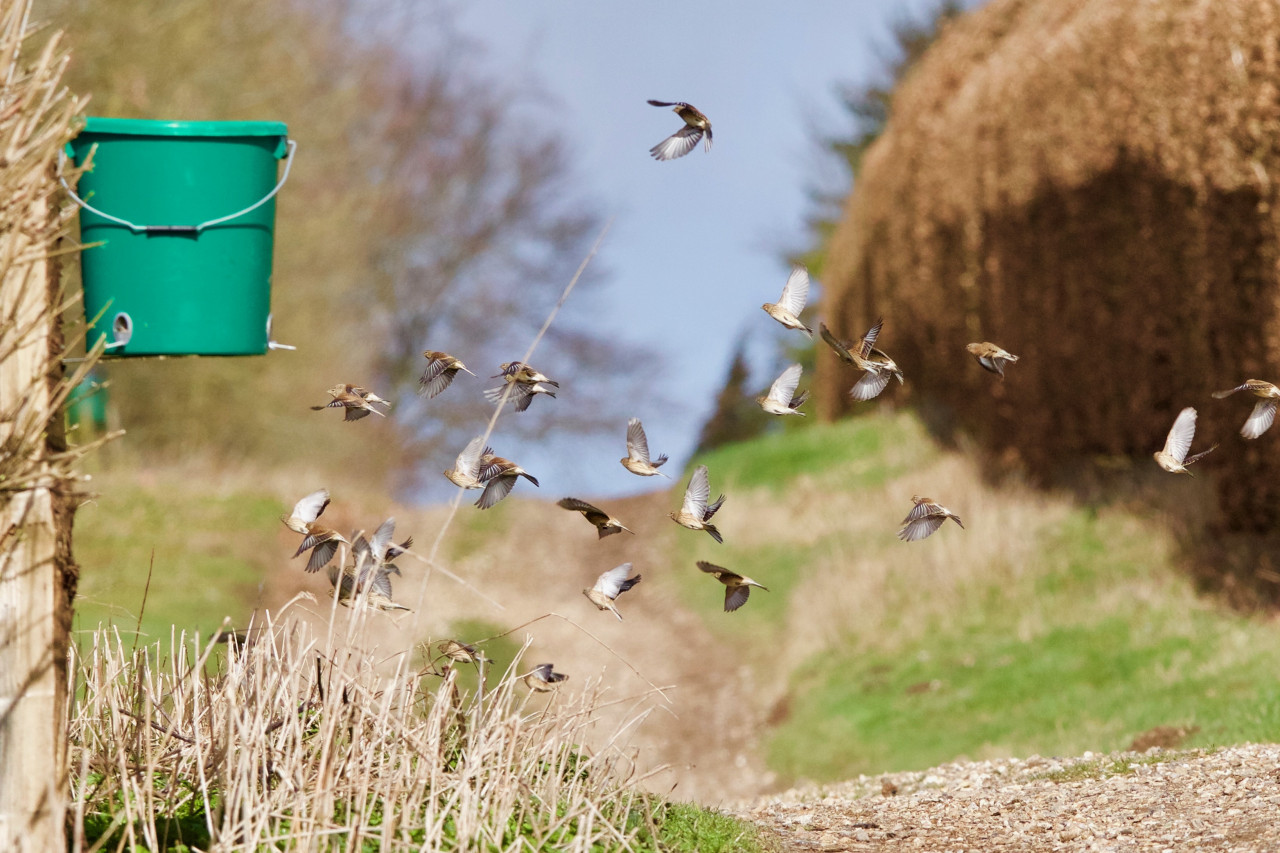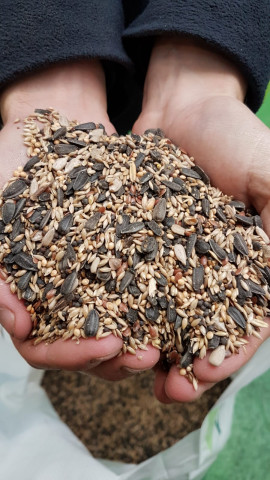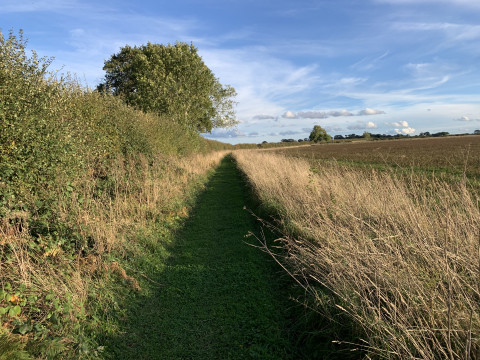Supporting farmland birds this winter with supplementary feeding
Supplementary feeding provides a vital lifeline for farmland birds in late winter and early spring on arable and mixed farms. It supplements crops of wild bird seed mix with additional seed such as cereal, oilseed and specialised grains like sunflowers, canary seed and millets. No matter how well wild bird seed plots are managed, they will inevitably run out of seed during late winter (December to April), a period known as the 'hungry gap'. Supplementary feeding plugs the hungry gap and enables farmland birds to enter the breeding season in a strong position.
Although supplementary feeding happens every year, it's important to remember how it complies with Stewardship schemes and how it can fit into your existing practices and interests.
How supplementary feeding incorporates with Stewardship
Not only can you have the joy and spectacle of flocks of small birds flying around your chosen sites, you can also get paid for carrying out the option as part of a Higher Level Stewardship (HLS) agreement or a Countryside Stewardship (CS) agreement.
Higher Level Stewardship
In HLS, the supplementary feeding option is referred to as HF24 and the payment rate is £822 per tonne of feed. In this option, the seed mix should be made up of 60% cereal (wheat, barley, triticale, rye and oats), 5% oilseed rape and an additional 35% of small seeds. The latter are typically from the following list:
- Canary seed
- Linseed
- Red and white millet
- Quinoa
- Sunflower hearts
- Black sunflowers
- Mustard.
Countryside Stewardship
In CS, the 'supplementary winter feeding for farmland birds' option is referred to as AB12 and the payment rate is £657 per tonne. The seed mix needs to be 70% cereal (wheat, barley, triticale, rye and oats) and 30% small seeds from the following list:
- White millet
- Red millet
- Canary seed
- Oilseed rape
- Black sunflowers
- Sunflower hearts
- Linseed
At least three small seeds should be present and no single small seed should make up more than half of the small seed component.
Timing and frequency
In general, the supplementary feeding window runs from December to April and feeding should take place at least once a week at two or more feeding sites.
In HLS, the amount of supplementary feeding will have been agreed between you (the agreement holder) and Natural England (NE). The amount of feed will be detailed on the HF24 prescription, which forms part of the agreement documentation.
Under a CS agreement, you can feed up to a maximum of one tonne of supplementary feed (AB12) for every two hectares of wild bird seed mix (AB9).
Where to place the seed
When carrying out supplementary feeding, the choice of feeding area is important.
It's best to feed on hard tracks where possible so the seed is easy for birds to access. Sites adjacent to good hedges are recommended as they provide cover, while feeding in close proximity to farm buildings is not recommended given the risk of attracting pests such as rats. Where the level of feeding is greater than the demand from farmland birds, the amount of feed should be reduced to try to match the uptake.
Feeding smaller quantities at the outset helps you judge the uptake of seed, which will generally increase as the birds get used to the feed areas as the weather gets colder. If you are feeding for Countryside Stewardship, remember no more than 10% of the feed can go through hoppers.
There are many ways to carry out supplementary feeding, depending on what kit is available to you. Methods include using a slug pelleter, a spinner on the back of a quadbike, or you could even hang a bag of seed from the wing mirror, cut a hole in the bottom and drive down the tracks! Whichever method is adopted, try to thinly scatter the seed along the chosen lengths of track or margin.
Perdix Farmland Feeders
Kings supplies both standard and automatic feeders from Perdix. These feeders can be moved around easily to help with the rotation of supplementary feeding locations. See an example in the image below.
Your game interests covered
Another reason to supplementary feed is if you have a shooting interest. Many shoots will already be feeding birds wheat and/or kibbled maize, so adapting this feeding regime to include small seeds is easily done and has already been adopted by many shoots. If you replace some or all areas of the maize game plots for wild bird seed mixes, it releases both a payment for the game cover and for the supplementary feed – it's a win-win for shooting and conservation interests.
Big Farmland Bird Count – get involved!
Every year mid-way through the hungry gap, roughly from the 4th to the 20th of February, the Game & Wildlife Conservation Trust runs its Big Farmland Bird Count.
This voluntary count is a fantastic way to not only see the results of supplementary feeding first hand, but it helps you gather vital records of how beneficial these practices are and allows you to see a variety of bird species on your farm/shoot while remaining compliant with a Stewardship scheme.
If you park at one end of a supplementary feed site (a vehicle makes a fantastic natural hide during the cold winter months) and allow the birds to settle again, all you need are some binoculars, our record book and maybe a bird identification sheet to help you with the less well-known winter visitors.
In 2022, over 1900 farmers took part and recorded 420,000 birds of 130 species across more than 1.5 million acres. We encourage you to take part in this count scheme. What are you feeding on your farm this winter?
Kings is here to help
At Kings we provide a wide range of supplementary feeding seed for both HLS and CS agreement holders, with options to suit a variety of budgets and scenarios. Our regional technical advisors are always on hand to offer advice and guidance too. You can also call our free technical helpline on 0800 587 9797.
Whether you sign up for this option for environmental or economic reasons, or a combination of the two, your actions will help farmland birds get through whatever the winter throws at them.
Find out more about our supplementary feeding offer here or get in touch.
As a subscriber, you’ll receive email alerts each time a new blog is published so you can always stay updated with the latest advice and insights from our experts









Comments